News
Interview with Mitchell Silver
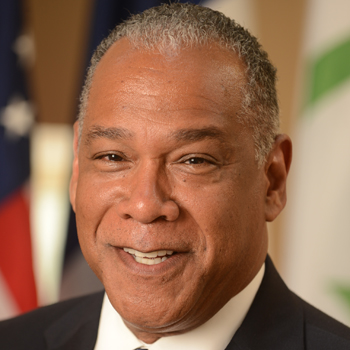 Mitchell Silver / NYC Parks and Recreation
Mitchell Silver / NYC Parks and Recreation
In 2014, Mayor Bill de Blasio launched the Community Parks Initiative, which aims to improve historically underfunded parks in densely populated and growing neighborhoods with higher than average concentrations of poverty. Some $285 million has been set aside for this effort, which will lead to the full re-imagining of 67 parks. Your department has broken ground in some 35 parks. What do communities want most for their new spaces after all those years of deferred maintenance? What are some common elements in these new places?
First, they want the asphalt gone. Most of these parks were just play spaces with asphalt. They want trees and green space. Even if it's synthetic turf, they want a softer surface. Second, they want multi-generational spaces. We have an aging population and want make sure we have seating areas, gathering spaces, so it isn't just a playground. And then, people want fitness equipment, or adult play equipment, which is a big trend right now. People want to come out and be healthy. And spray showers, because, if you have a pool, you can only use it a few months a year. With spray showers, you can still play on the same surface in the winter. In the summertime, they're self activated, you can just cool off and enjoy without getting fully wet. Those were some of the primary ones, but number one is people want the asphalt gone. They want to go from gray to green.
Another exciting initiative you're leading: Parks Without Borders. Some $50 million will be spent on improving park access through "opening sight lines, beautifying edges, adjusting furnishings." Part of this will include lowering all those tall chain-link fences, unappealing gates, and fixing the sidewalks lining the parks. Can you talk about the connection between a park and it surrounding streets? Why focus on the borders? Why are they so important?
Frederick Law Olmsted once said the sidewalk adjacent to the park is the outer park. If you look at Prospect Park and Central Park, the sidewalk is part of the park. When I came on board, I recognized that in our city charter, the parks department not only oversees the parks, but the sidewalks adjoining the parks. The park doesn't end at the fence line or the wall, it actually ends at the curb and beyond.
The second point is park land represents 14 percent of the city's footprint. Streets and sidewalks represents another 26 percent. So in other words, 40 percent of New York City is within the public realm. We own it, yet the average citizen does not know where the parks department property ends and the department of transportation property begins. And guess what? They don't care. They want a seamless public realm.
That gave birth to the Parks Without Borders. Parks aren't just islands of green space; they're connected to our entire public realm. Parks Without Borders help us create a more seamless experience at the edges, entrances, and adjacent park spaces. We don't have to buy new land; we own it. We just have to program it differently, so we provide a better experience.
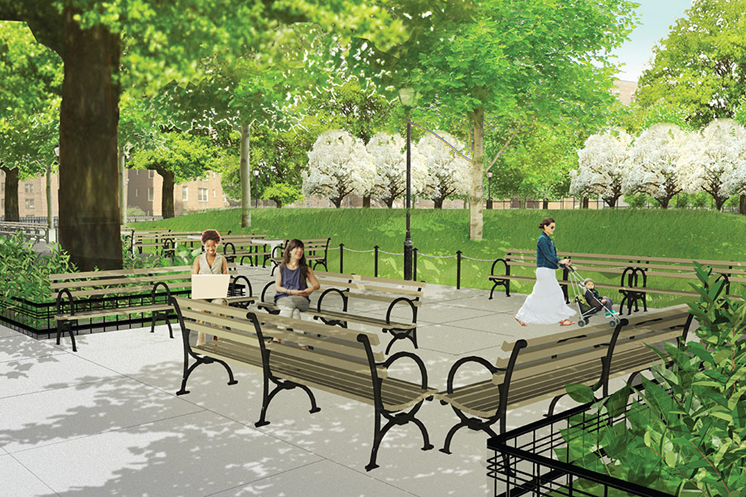 Parks without Borders / NYC Parks and Recreation
Parks without Borders / NYC Parks and Recreation
But are you concerned about security when you lower all those fences?
We're always concerned about security. But here's the good thing about Parks Without Borders: We met with our police department and they fully support the effort. Why? Because when you lower the fences, it increases natural surveillance. There are now more eyes on the park. We're also removing landscaping and vegetation and other obstacles that block views. People who want to do bad things do not want to be seen. By removing the obstacles, improving the lighting, and increasing the sight lines into the park, we can actually make parks safer. Part of Parks Without Borders is also a public safety campaign.
We need fences for children to play and for certain recreation, but, for the most part, we don't really need them. Without fences, we can create a more seamless experience.
Parks Without Borders is about making parks more welcoming, open, turning them into the living rooms of the city. It's about removing all of these tall fences where young people feel, "Why are you imprisoning me in this public space?" We're no longer in the '80s and '90s anymore. Parks are safe.
Another part of Parks Without Borders is bringing free Wi-Fi to city
parks. New York City parks and recreation has partnered with AT&T. You've piloted benches that enable you to recharge your phone via solar
panel while browsing on Wi-Fi. But aren't parks meant
to be an escape from technology in urban life? Doesn't time spent
downloading apps diminish time enjoying Central Park?
We carefully look at the
demographics. From the Greatest generation, to the Boomer generation, and the X, Y,
Z generations, people experience parks in different ways. Years ago in
Bryant Park, there would be couples using the movable chairs,
enjoying their public space. Today, people go by themselves with their
smartphones. The smartphone is
the most necessary device. It connects people to the
world. I'm totally fine with that. Some people go to parks purposely to
read a book, but they can also be alone with their smartphone.
People may want to look for
something within the park, download a map to see where they're
going, meet up with a friend, or pull out
their phone and take photographs and selfies and tweet them
out. We want to encourage those activities.
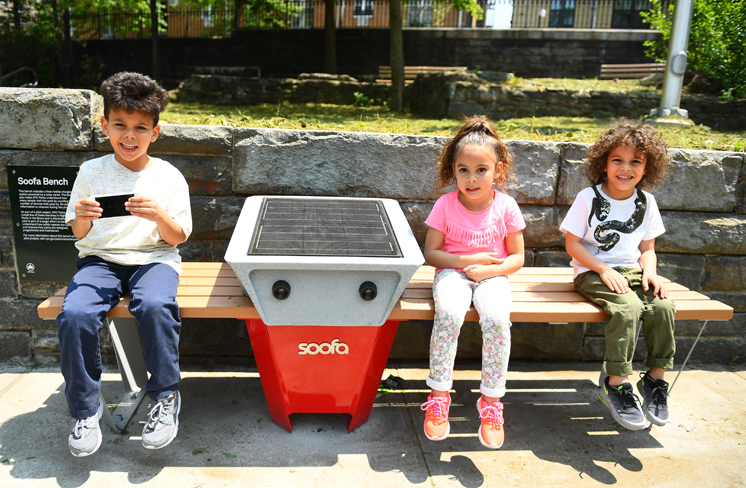 Soofa Charging Bench / NYC Parks and Recreation
Soofa Charging Bench / NYC Parks and Recreation
For me, technology and
parks go together. I love
taking pictures of people taking pictures in parks. Very often, you
know you have a popular park when someone pulls out their phone and they
start taking selfies.
We've put in charging stations at beaches. Who knows? Maybe you may can meet your future
husband or wife getting your phone charged on the beach. I don't see
any disconnect: Technology and parks definitely go together.
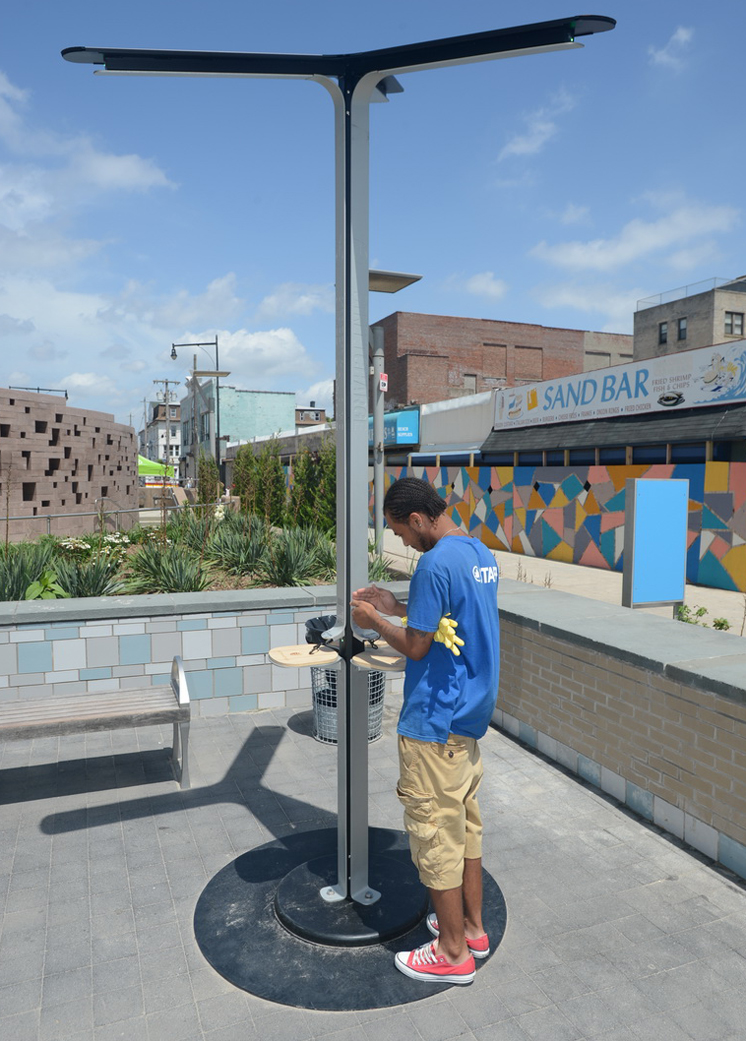 Beach Charging Station / NYC Parks and Recreation
Beach Charging Station / NYC Parks and Recreation
You said the newly-rebuilt 5.5 mile Rockaway Boardwalk is a part of New York City's "first line of defense against climate change." The boardwalk features "multiple layers of protection" with six miles of planted dunes backed by concrete retaining walls. When the new super storm hits, how is that reconstructed shoreline expected to perform? And how do you know?
Super Storm Sandy established a new reality for New York City. We never thought we were that vulnerable. In New York City, we have 520 miles of coastline and 155 miles are within parks. So in each neighborhood, we're looking at a different approach of how to address risks, but there's no question our parks are now the first line of defense.
In the Rockaway, we worked with our landscape architects and engineers. We did beach replenishment. We put in dunes. We use concrete as opposed to piles of wood. What we've built will do a much better job at saving life and property. What we've built is stronger and better.
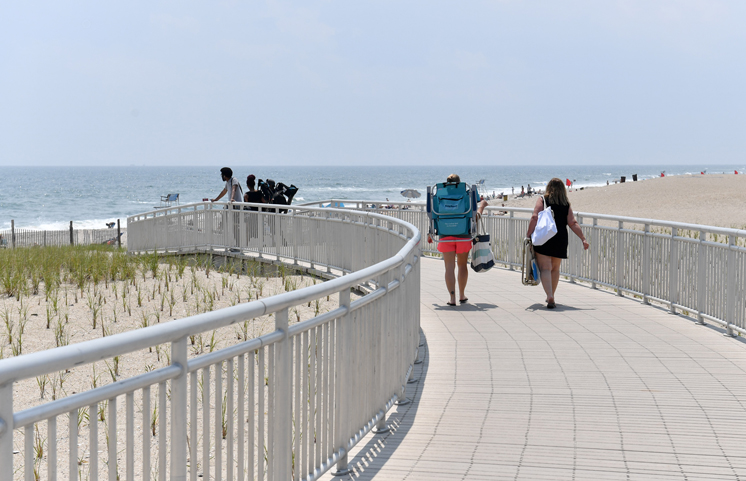 Rockaway Beach Protective Dunes / NYC Parks and Recreation
Rockaway Beach Protective Dunes / NYC Parks and Recreation
And that's our goal moving forward. Solutions will vary between different neighborhoods, but the Rockaway shows one example of a very vulnerable neighborhood that now has a concrete boardwalk that's reinforced with dunes on both sides.
Clearly we're going to be tested one day. We hope not soon.
Parks, plazas, even playgrounds, can be part of a city's system for protecting itself against storms and floods. As the Big U, the set of parks that double as berms, take shape in Lower Manhattan, your city is showing the way forward on how to create protective infrastructure that doubles as a public park. How do roles and responsibilities change when you have a $350 million dollar piece of public multi-use infrastructure charged with protecting billions of dollars of real estate in Lower Manhattan? Are you creating a governance model for this system that other cities can use?
Under our previous mayor and current mayor, the Mayor's Office for Resiliency, Recovery and Resiliency has been the overarching coordinating agency that works with all the relevant agencies, such as parks, environmental protection, and transportation. They take the lead role, even though all the resilient infrastructure is placed in the park. The Big U is not just about green infrastructure but also acts as a protective infrastructure to protect life and property.
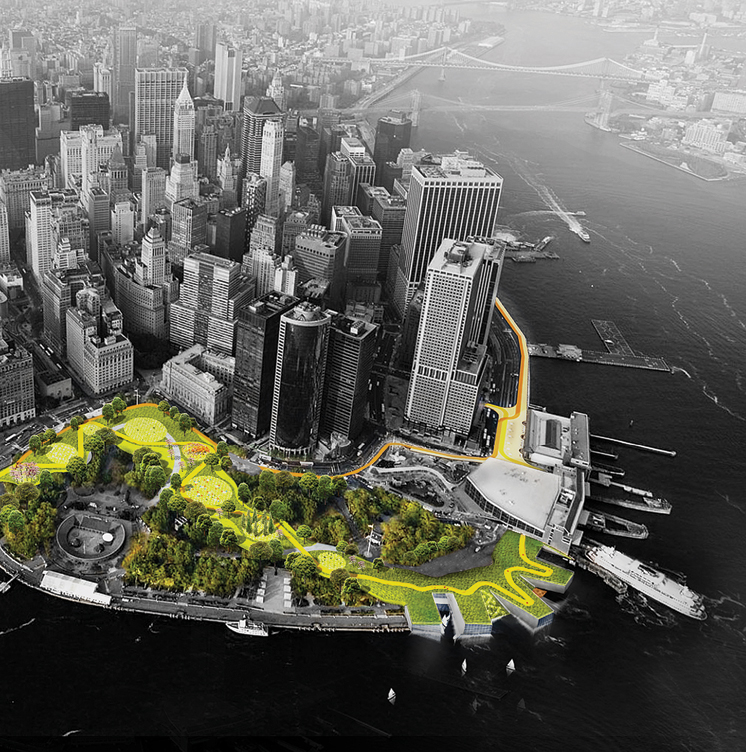 ASLA 2016 Professional Analysis and Planning Honor Award. Rebuild by Design, The Big U / BIG and Starr Whitehouse Landscape Architects and Planners
ASLA 2016 Professional Analysis and Planning Honor Award. Rebuild by Design, The Big U / BIG and Starr Whitehouse Landscape Architects and Planners
We need to be a resilient city. Sea levels are increasing over time, and New York City is a coastal city. We recognize we have to plan for change now. All these projects are also taking into account sea level rise in a city that is basically an island, except the Bronx, which is part of the mainland.
The Office of Recovery and Resiliency is a model that other cities should emulate. They have designers, engineers, planning professionals, and policy makers that focus on resiliency efforts throughout the world. They focus on this day in and day out. Parks will then bring in their experience because we know plant material, horticulture. We know how to plan for different type of environments in our city and how to protect the environment. But an overarching agency that spends all of their time focused on recovery and resiliency is a good coordinating mechanism.
You told The New York Times that part of your Sunday routine is to visit a park you've never been, a new one out of the whopping 1,700 parks in five boroughs you oversee. You see who is visiting, take photos, document issues. What have your Sunday adventures taught you about the park system that you couldn't read in a briefing book?
Taking these surprise visits, I've learned that our parks are cleaner than I thought. I get a lot of reports about people complaining how filthy our parks are. That is not the case. There were a couple of instances, but our parks are a lot better maintained than I would believe just by doing these spontaneous visits.
Second, New Yorkers love parks. I spend a lot of time watching where people are sitting, what they're doing. On a hot sunny day, a spot under a tree is a very popular spot.
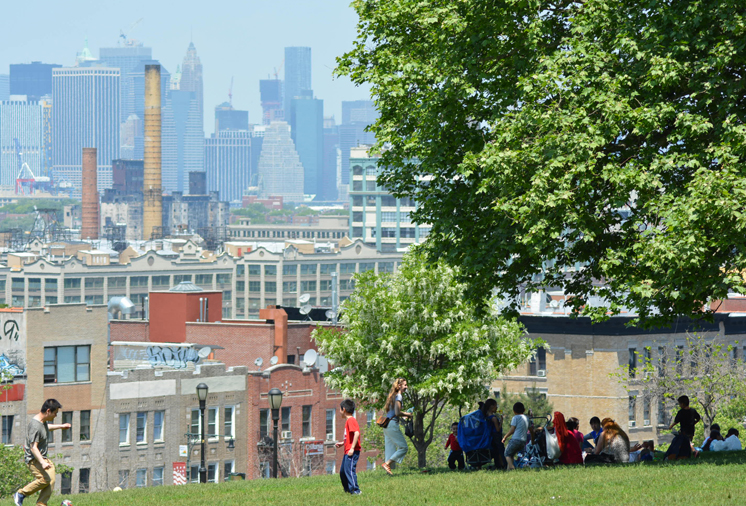 People enjoying the shade under a tree at Sunset Park / Mitchell Silver
People enjoying the shade under a tree at Sunset Park / Mitchell Silver
I look at how different generations are using the spaces, what seniors and families are doing.
I knew we lacked capital investment and, so, going into certain parks, I knew we had to focus on finding a way for some of our lesser known parks to get an infusion of capital. That has became obvious to me.
There are certain parks that did have some maintenance issues, but I realized staff did not have the proper equipment. I didn't go into these parks to whack staff. I want to find out what I need to give them to do their jobs better. Now we have a whole new approach to make sure the service for our equipment is better and staff have the tools they need to maintain this park.
I live in Brooklyn, I grew up in Brooklyn. I had no idea we had such an incredible park system. I was blown away by parks I'd never heard of. I just came from Bowne Park in Flushing, Queens, which is beautiful. I'm going to parks and saying, "I cannot believe I'm in New York City." I had a chance to take a canoe down the Bronx River and I was transported to another place.
I want to go on my own, unannounced without staff, just to be free to explore and see how people are using spaces. I love photography, so enjoy taking pictures of some of my favorite moments in these parks.
Lastly, given Mayor de Blasio's focus on creating One City in NYC, what role do you think public space like parks, greenways, playgrounds play in reducing inequality? Can they reduce poverty?
Parks are free. They're democratic spaces. Regardless of your race, income, age, parks are accessible to everyone.
We do have our quality regional parks -- Central Park, High Line, Prospect Park -- open to everyone. But we want to take that a step further: Every neighborhood deserves to have a quality space. We want everyone to be within a ten minute walk to a park. But it's not just the proximity, we want that park to be a quality park.
We launched the Community Parks Initiative because we believe parks are places where people connect, get healthy, and relax. Having that in every neighborhood addresses inequality. We want to make sure we're fair about how we invest in our parks, and all young kids have a chance to enjoy green spaces and get healthy.
I can't say parks address poverty per se, but they certainly address inequality. Everyone deserves a quality space in New York City, where density and open space go together. You cannot have one without the other. You don't just want to have affordable housing. You want to have a quality neighborhood with adequate public space.
Mitchell Silver is commissioner of the New York City Departments of Parks and Recreation. Silver is past president of the American Planning Association (APA) and an award-winning planner with 30 years of experience. Interview conducted by Jared Green at the ASLA 2016 Annual Meeting in New Orleans.